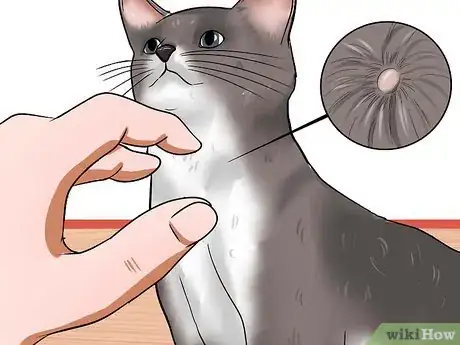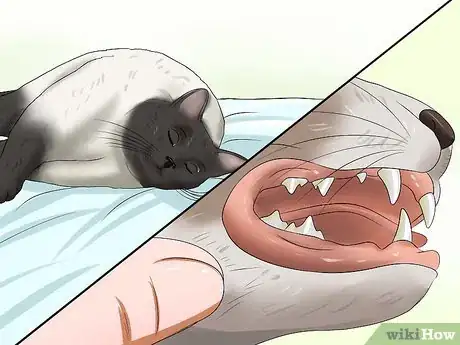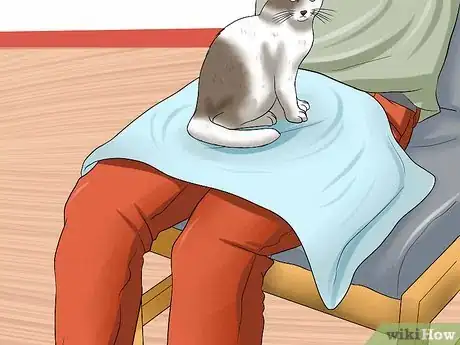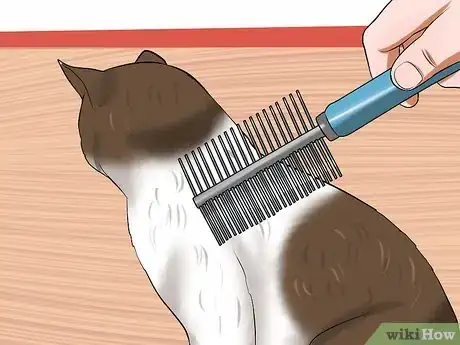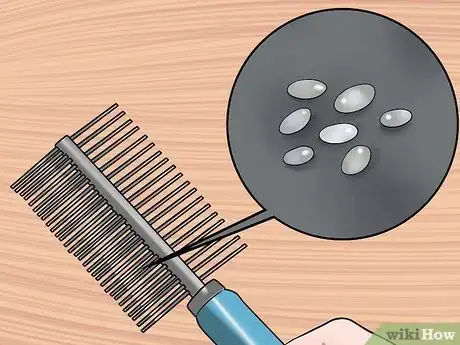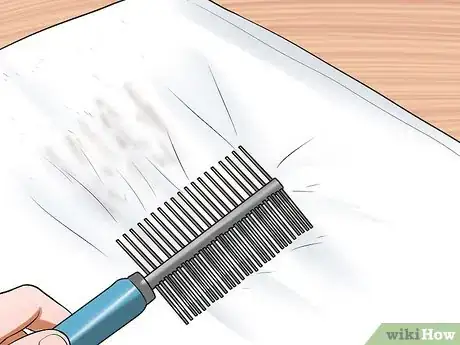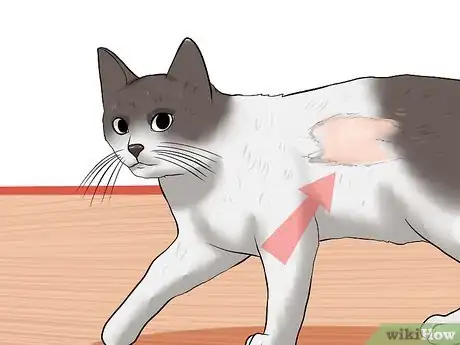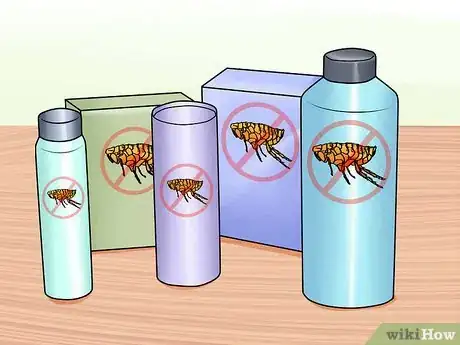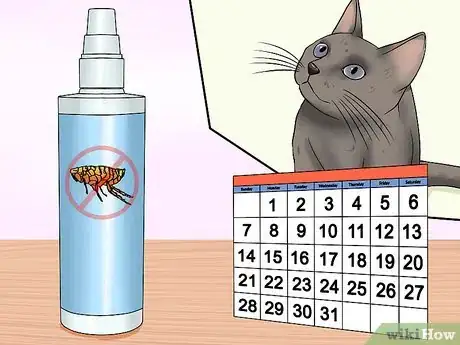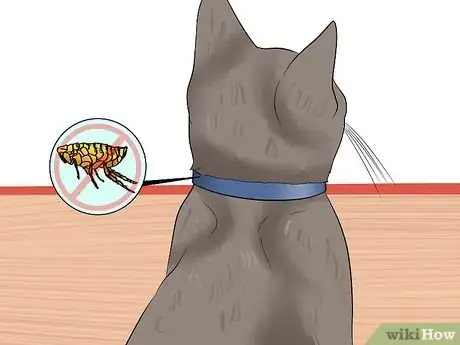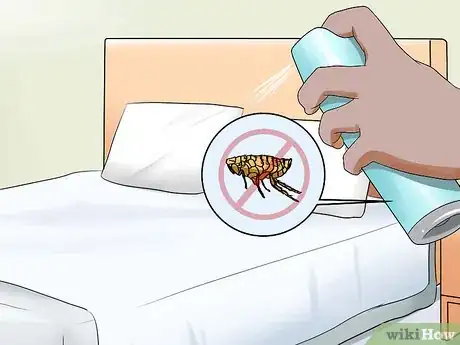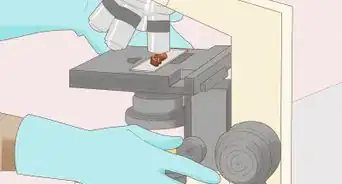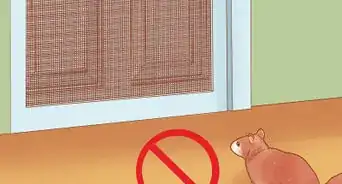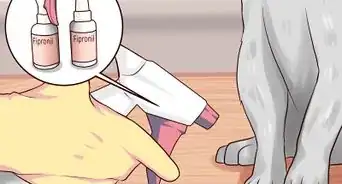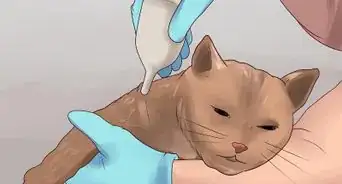This article was co-authored by Pippa Elliott, MRCVS. Dr. Elliott, BVMS, MRCVS is a veterinarian with over 30 years of experience in veterinary surgery and companion animal practice. She graduated from the University of Glasgow in 1987 with a degree in veterinary medicine and surgery. She has worked at the same animal clinic in her hometown for over 20 years.
There are 14 references cited in this article, which can be found at the bottom of the page.
wikiHow marks an article as reader-approved once it receives enough positive feedback. In this case, 95% of readers who voted found the article helpful, earning it our reader-approved status.
This article has been viewed 386,464 times.
Before you go on a flea hunt, think about why you suspect your cat might have fleas. If you've seen fleas on your cat or in your house, you know for sure you are dealing with fleas and should use a veterinary flea treatment labeled for cats. But, you may have a flea problem even if you've never seen a flea on your pet or in your home. Your cat may have cleaned the adult fleas from her fur. Flea eggs may have fallen off your pet and could hatch a few weeks later. Either way, it's important to know for certain if your cat has fleas.
Steps
Assessing Your Cat's Symptoms
-
1Pay attention to your cat's grooming. If your cat is sensitive to fleas, she may have an allergic reaction. Even cats that are not allergic to flea saliva experience irritation and itching from individual bites. This triggers excessive grooming behavior. Your cat may clean herself so often and thoroughly that she removes the fleas. It may be harder to spot the fleas since they hop on to the cat to feed and hop off again, so they only temporarily appear. This explains why your cat can have fleas even if you can't find them.[1]
- Signs of flea infestation will be different depending on your cat's health, the number of fleas on the cat and other individual factors.
-
2Look for flea symptoms. Flea bites are very irritating. Watch your cat for the following flea symptoms:[2]
- small bumps or crusts, usually on the neck and along the back
- skin irritation, especially on the back of the neck and base of the tail
- increased scratching, especially around the face
- increased grooming
- hairballs from excessive grooming
- hair loss
- passing tapeworms in the stool (fleas carry tapeworm eggs which cats ingest and pass)[3]
Advertisement -
3Pay attention to your cat's behavior. Your cat may suddenly avoid rooms she used to enjoy, especially if they're carpeted and are harboring fleas. Your cat might also appear restless or edgy. She may even start growling or shaking her head a lot. Your cat may be trying to get rid of the fleas.
- Some cats may be more sensitive to flea bites and will appear more bothered by the flea bites. They may develop strange behaviors because they are uncomfortable.
-
4Watch for signs of anemia. If the flea infestation is really bad in your cat, not only will she have a lot of fleas in her coat, but she may suffer from blood loss and develop anemia. If so, look for lethargy or extreme tiredness, pale gums, and muscle loss. You should also check the flea dirt against a wet white towel to be sure of fleas. Regardless of whether your cat has fleas, you should take her to the vet if she's anemic.[4]
- Kittens and elderly cats are more likely to get anemia from flea infestation.
Looking for Fleas on Your Cat
-
1Secure your cat. Set your cat on a white sheet or pillowcase. The white fabric will let you see any fleas or flea dirt you might dislodge. If you want to hold the cat in your lap while combing, drape your lap with the cloth first.
- Fleas are dark brown wingless insects about 3 to 4 millimeters in length.[5] You may notice them jump away as you work. Check in between the cat's legs on their bellies. Part the fur here as it is a common place for fleas to inhabit.
-
2Comb your cat's fur. Comb the cat from head to tail with a flea comb and examine the fur and exposed skin as you work. Pay particular attention to the back of the neck, the base of the tail and the insides of the legs. These are favorite hiding spots of fleas.[6]
- Flea combs are designed to trap fleas on the teeth of the comb. The teeth are so close together that the flea cannot escape and is brought to the surface.
-
3Examine the flea comb. Even if you don't find jumping fleas, you may find flea excrement or flea eggs, which look like salt and pepper. If you find any suspicious material, place it on a damp paper towel. Flea excrement contains blood, so it turns dark red when it gets wet.[7]
- If you notice this flea excrement, or flea dirt, there are fleas somewhere on your cat.
-
4Check for flea feces or flea dirt. Shake the dirt from the comb and her fur onto the white sheet so you can see the black specks. To distinguish normal dirt from flea feces, sprinkle a little water over the specks. If it's flea dirt, the black specks will turn red-brown or orange with a halo effect.[8]
- This is easiest if you placed your cat on a white towel or sheet when you combed her.
-
5Look for patches of hair loss. There are several reasons that fleas might contribute to your cat's hair loss. Your cat may be irritated by the constant biting and scratches her fur a lot, leading to patches of hair loss. Or, your cat might be allergic to flea saliva which irritates the skin and causes extra scratching.[9]
- Your cat may be allergic to something other than fleas. If you don't find fleas, but your cat is still constantly scratching, take her to the vet.
Giving Your Cat Preventative Flea Treatment
-
1Find a flea treatment. Even if you don't find fleas, you should consider using a product that both protects your cat from fleas and treats current infestations. Modern flea preventatives are safe and extremely effective. Some can be purchased over the counter and others are only available from veterinarians.
- Choose a product specifically for feline use since some dog products contain ingredients that can be harmful to cats. Check with your veterinarian for help choosing a product that meets your cat's needs.
-
2Treat your cat with monthly flea medication. Follow the packaged instructions or your vet's directions when giving the medication. Treatment will protect your cat from future flea problems and will tell you whether it was a flea problem that caused your cat's symptoms. If the problem goes away after treatment, fleas probably contributed to the issue even if you never saw them.
- Monthly preventative treatments are available orally, as injections, and as topical medications.[10]
-
3Choose a flea collar that is approved by your vet. There are a variety of flea collars on the market. Some work well, while others don't work at all, and some may be toxic to your cat.[11] Therefore, it's important to talk with your vet before using a flea collar.
- Consider putting a flea collar in your vacuum bag or canister to kill any fleas that you vacuum up.[12]
-
4Prevent fleas from infesting your home. Vacuum all the carpets, rugs, and upholstery every day. Be sure to throw away the vacuum bag in an outside dumpster so the fleas can't get back out. You should also wash your pet's bedding in hot water to kill any fleas.
- If you have a flea infestation that you can't seem to get rid of, you may need to use a household fogger. This releases toxins that kill the fleas and their eggs, but it may be harmful to pets and children. Carefully learn about foggers before using them.[13]
Expert Q&A
-
QuestionCan fleas be passed on to people from a cat?
 Pippa Elliott, MRCVSDr. Elliott, BVMS, MRCVS is a veterinarian with over 30 years of experience in veterinary surgery and companion animal practice. She graduated from the University of Glasgow in 1987 with a degree in veterinary medicine and surgery. She has worked at the same animal clinic in her hometown for over 20 years.
Pippa Elliott, MRCVSDr. Elliott, BVMS, MRCVS is a veterinarian with over 30 years of experience in veterinary surgery and companion animal practice. She graduated from the University of Glasgow in 1987 with a degree in veterinary medicine and surgery. She has worked at the same animal clinic in her hometown for over 20 years.
Veterinarian Cat fleas don't live on people, and the latter don't become infested in the same ways cats and dogs. People do get bitten by fleas, but by accident. However, some people are allergic to flea saliva, which is why they can become so itchy and uncomfortable.
Cat fleas don't live on people, and the latter don't become infested in the same ways cats and dogs. People do get bitten by fleas, but by accident. However, some people are allergic to flea saliva, which is why they can become so itchy and uncomfortable. -
QuestionA week ago I adopted a 6-month old kitten infested with fleas. He's been in the washroom in isolation. He's had Frontline Plus applied to his neck, and had three doses of Capstar. When can I let him loose in the home?
 Pippa Elliott, MRCVSDr. Elliott, BVMS, MRCVS is a veterinarian with over 30 years of experience in veterinary surgery and companion animal practice. She graduated from the University of Glasgow in 1987 with a degree in veterinary medicine and surgery. She has worked at the same animal clinic in her hometown for over 20 years.
Pippa Elliott, MRCVSDr. Elliott, BVMS, MRCVS is a veterinarian with over 30 years of experience in veterinary surgery and companion animal practice. She graduated from the University of Glasgow in 1987 with a degree in veterinary medicine and surgery. She has worked at the same animal clinic in her hometown for over 20 years.
Veterinarian Anytime from now onwards is fine. Capstar has a rapid kill effect and will knock dead any fleas on the cat that day. Frontline takes longer to kill the fleas but it has a longer persistence of activity — around four weeks. Thus, any fleas that he originally bought in with him should be well and truly dead by now.
Anytime from now onwards is fine. Capstar has a rapid kill effect and will knock dead any fleas on the cat that day. Frontline takes longer to kill the fleas but it has a longer persistence of activity — around four weeks. Thus, any fleas that he originally bought in with him should be well and truly dead by now.
wikiHow Video: How to Check Cats for Fleas
Warnings
- If your cat has fleas, you're at risk for being bitten by fleas.⧼thumbs_response⧽
- Fleas can cause blood-loss anemia, especially in kittens, and spread diseases, including typhus-like Rickettsia and Bartonella. They also spread tapeworms and cause skin irritation.[14]⧼thumbs_response⧽
- Flea pupae can remain dormant for several months. So, it's important that once you notice a flea problem you use a preventative treatment on your cat and thoroughly clean your home. You should also treat potential problem areas with a product safe for indoor use to prevent fleas from returning.[15]⧼thumbs_response⧽
References
- ↑ http://pets.webmd.com/cats/guide/cats-and-compulsive-scratching-licking-and-chewing
- ↑ Sue Patterson, Manual of Skin Diseases of the Dog and Cat, (Chicester: Wiley-Blackwell, 2009), 123-129.
- ↑ Patrick J. McKeever, Tim Nuttall and Richard G. Harvey, A Colour Handbook of Skin Diseases of the Dog, Second Edition, (London: Manson/Veterinary Press, 2009), 41.-42
- ↑ http://pets.thenest.com/tell-cat-fleas-dry-skin-11385.html
- ↑ William J. Foreyt, Veterinary Parasitology Reference Manual (Ames, Iowa: 2001), 40.
- ↑ https://www.aspca.org/pet-care/cat-care/fleas
- ↑ https://www.aspca.org/pet-care/cat-care/fleas
- ↑ http://www.petmd.com/cat/parasites/evr_ct_does_my_cat_have_fleas
- ↑ http://pets.thenest.com/can-fleas-cause-bald-spots-sores-cats-8815.html
- ↑ http://www.petco.com/Content/ArticleList/Article/13/2/1863/Flea-and-Tick-Prevention-for-Cats.aspx
- ↑ http://www.petcarerx.com/article/combining-flea-treatments-what-you-need-to-know/140
- ↑ http://vetmedicine.about.com/cs/diseasesall/a/befreeoffleas_2.htm
- ↑ http://www.petmd.com/cat/slideshows/parasites/10-ways-to-stop-biting-fleas-on-cats
- ↑ McKeever, Nuttall and Harvey, A Colour Handbook of Skin Diseases of the Dog, Second Edition, 41-42. http://www.merckvetmanual.com/mvm/integumentary_system/fleas_and_flea_allergy_dermatitis/overview_of_fleas_and_flea_allergy_dermatitis.html
- ↑ McKeever, Nuttall and Harvey, A Colour Handbook of Skin Diseases of the Dog, Second Edition, 41-42.
About This Article
To check a cat for fleas, drape a white sheet over your lap and set your cat on it. Then, comb your cat with a flea comb while visually checking for fleas, which are small and brown. Some of them may jump off onto the cloth while others will get stuck in the comb or remain on the cat. Even if you don’t see fleas, check your cat and the cloth for flea eggs and feces, which look like salt and pepper. For advice from our Veterinary reviewer on symptoms and treatments for fleas, read more!

